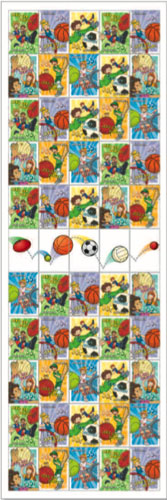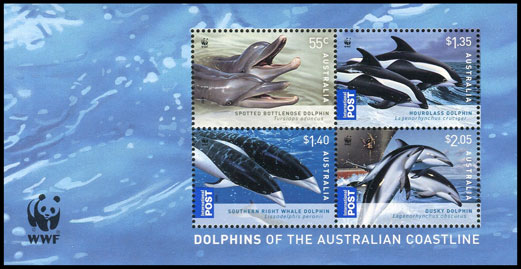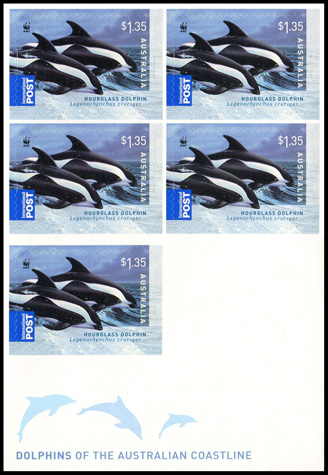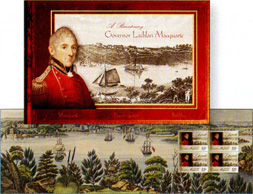
Home > Glossary
Perforations
What are perforations?
'Perforation' is the effect of removal from a sheet of stamps of many small, usually circular, pieces of paper. This allows the stamps to be separated from each other, usually by folding along the perforations, and then tearing.
How are perforations measured?
Perforations are measured by the number of holes or cuts within a length of two centimeters. This is called the perforation gauge.
Perforations are quoted as horiz x vert.
There are many tools on the market for determining the perforation gauge. The two I use almost exclusively are Stanley Gibbons' Instanta gauge, and Lighthouse's CombiBox. The Instanta gauge is useful for all types of stamps, whether on or off paper, but requires a lot of practise to be used efficiently. The CombiBox is best for
Measuring perfs - show Instanta etc.
Perforations can be measured by counting the number of holes in a length of two centimeters; or by counting the number of holes along a side, dividing this by the length of the stamp, and multiplying by two. However, these methods are very time-consuming and are liable to be inaccurate, especially if the the number of holes is miscounted, or the stamp size is measured incorrectly.
In some rare cases the perforation gauge changes along the length of a stamp. This is called a compound perforation.
Perforation Gauge Conventions
This website adopts the European and American standard of rounding perforations to the nearest quarter, with perforations measured as described above. Thus a stamp with a perforation gauge of 14, measures between 13.88 and 14.12.
More accurate measurements are generally unnecessary. As Australian stamps are comb perforated, then there are a whole number of holes along each side. The current perforating combs place 26 holes along a length of 37.5 mm, producing a gauge of 13.87 (rounded to 13¾). If this was reduced to 25 holes, then the gauge would be 13.33 (rounded to 13¼); or increased to 27 holes, then the gauge would be 14.4 (rounded to 14½).
Australian Stamp Printers
Since decimalisation Australia has used a large number of stamp printers.
Leigh-Mardon
In ? Leigh-Mardon took over the CPE plant in Scoresby. Stamps printed from this plant are indicated by 'Leigh-Mardon, Scoresby', with the original plant indicated by 'Leigh Mardon, Morrabin'.
Leigh-Mardon withdrew from Australian stamp printing in May 1995, although it did print the Festive Framas in 1996 and Tiwi Framas in 1999 as they were the only security printer with a rotary press.
CPE
CPE (Cheque Printers and Encoders Australia Limited)
McPherson's Printing Group
Technically printed by Owen King Pty Ltd, McPherson's is the parent company, and has requested to be recorded as the stamp printer. It is also believed they printed the imperforate ANZAC miniature sheets in 2008 under the name Bang Stationery and Printing.
Pemara Labels Pty Ltd
Pemara printed the first self-adhesive stamps (41c Cycling stamps) in 1990. For many years Pemara only produced self-adhesive definitive stamps using the letterpress process (typography), but since 1998 uses lithography for its self-adhesives. Pemara also produces stamps by flexography in combination with special features such as scratch and sniff panels, flocking and foiling. During 2008 Pemara also printed some sheet stamps.
Printset Cambec
...
Singapore National Printer took over operations from Printset Cambec on 10 July 1995, and changed its name to SNP Cambec. From 1 August 1998, it was known as SNP Ausprint, and SNP SPrint (Aust) from 1 July 2002. The company was known as SEP SPrint Australia on 20 January 2005. In 2008, SEP SPrint went into receivership.
Avon Graphics
First involved with the printing of the $20 Gardens definitive in 1990, Avon Graphics' main work with Australia Post has been special effects, such as foil die-stamping, holograms, and limited edition engraved printing. Avon Graphics has not be involved in printing Australian stamps for many years.
Canberra Press
The printer of the Australian Stamp Bulletin for many years, Canberra Press produced two issues for Australia Post, the Cocos Quarantine and National Council of Women issues in 1996. Canberra Press is now part of PMP Print.
McKellar Renown
Started
Energi Print
Along with McKellar Renown and Pemara, Energi Print is now one of Australia Post's main printers.
Printing Process
Lithography
Flexography
Issue Dates
The issue date given is the first day the stamps were valid for postage or the date they were on sale in a majority of Australian states, whichever is the latter. For most gummed and self-adhesive stamps these dates are the same.
Advance Orders
For many years Australia Post has allowed stamps to be ordered in advance - this includes both general issues, personalised stamps and special items (such as Impressions items). However, the Australian Philatelic Bureau and Fuji Xerox does not sent out the stamps until the stamps are released. If an official date of issue is not known, the invoice date from the Australian Philatelic Bureau or Fuji Xerox is quoted as the issue date.
Stamps Sold Before the First Day of Issue
At times, post offices have been known to sell stamps before the official date of issue. When this occurs it is noted, but the date of issue remains the first day of issue. Technically, it is impossible for pre-packaged products to be sold before the issue date. Each item's barcode is scanned and Australia Post's point of sale software will warn the staff member that the item has not been officially released.
Koala and Kangaroo Reprint
The issue date given for a koala and kangaroo reprint is the date the reprint was available for sale from post offices. As reprints are sent to post offices on an as needed basis, and are not officially released, it is impossible to give an exact date, hence only the month is given. In some cases the date can only be narrowed down to the first or second half of a year.
Papers
Papers
Harrison
The June 1997 Technical Details Booklet, reports that up to the middle of 1996, the base paper had optical brighteners in the fibres. Thus, the UV reaction on the back of the stamps is bluish white. From 5 September 1996, a 'new' Harrison paper without optical brighteners was introduced, giving a dull mauve UV reaction on the back (similar to CPL).
B90 and B100
sss
Tullis Russell
Australia Post exclusively uses Tullis Russell coated paper for all its gummed stamps.
Issuing Formats
Sheets
 Most stamps are issued in sheets. When the 'sheets' used it referes to a post office sheet (i.e. the sheet size released for sale to post offices). In Australia most stamps are released in sheets of 50 (shown at right), 20 and 10 stamps, with the occasional sheet of 12 and 16 stamps.
Most stamps are issued in sheets. When the 'sheets' used it referes to a post office sheet (i.e. the sheet size released for sale to post offices). In Australia most stamps are released in sheets of 50 (shown at right), 20 and 10 stamps, with the occasional sheet of 12 and 16 stamps.
Sheets of stamps may or may not have a gutter strip. These gutter strips may be illustrated or contain 'traffic lights' (circles of colour).
Sheetlets
The term 'sheetlet' is reserved for small sheets of stamps which contain stamps which have already been issued in larger sheets.
Miniature Sheets
A small-size sheet with the set (or part) of the issued stamps with decorative margins. Miniatures sheets are generally not broken up by post offices.

Booklet panes
A page of stamps from a booklet. Australia Post separates panes from prestige booklets into two groups 'stamp panes' or 'miniature sheet pane', where the pane is similar to the issued miniature sheet.
Booklets
Often stamps are issued in booklets. Most self-adhesive booklets contain either ten or twenty stamps, which are rouletted, and allow the booklet to be folded up. Unfolded booklets are sent to post offices in chequebooks of 20 stamps. Chequebooks are used to distribute booklets to post office, and I do not believe these are large booklets of 200 or 400 stamps.
For the purposes of consistency any small sheet of stamps which has a clear cover, and can be folded up to form a booklet (whether rouletted or not) without damaging the stamps is classed as a booklet.
 
A self-adhesive booklet and cover, clearly showing a cover
Prestige booklets contain pages of information interleaved with booklet panes. Prestige booklets often contain stamps in a different format to the original issue.

Prestige booklet and booklet pane
phosphorescence
Self-adhesive booklets ...
References
Fundamentals of Philately, L.N. Williams (published by the American Philatelic Society)
The 1990/91 Collectors' YearBook, Australia Post
Australia Post, Stamp Printing Technical Details, Various editions from January 1988 to June 2007
If you have more information, or spot an error, please e-mail me.
|


 Most stamps are issued in sheets. When the 'sheets' used it referes to a post office sheet (i.e. the sheet size released for sale to post offices). In Australia most stamps are released in sheets of 50 (shown at right), 20 and 10 stamps, with the occasional sheet of 12 and 16 stamps.
Most stamps are issued in sheets. When the 'sheets' used it referes to a post office sheet (i.e. the sheet size released for sale to post offices). In Australia most stamps are released in sheets of 50 (shown at right), 20 and 10 stamps, with the occasional sheet of 12 and 16 stamps.






